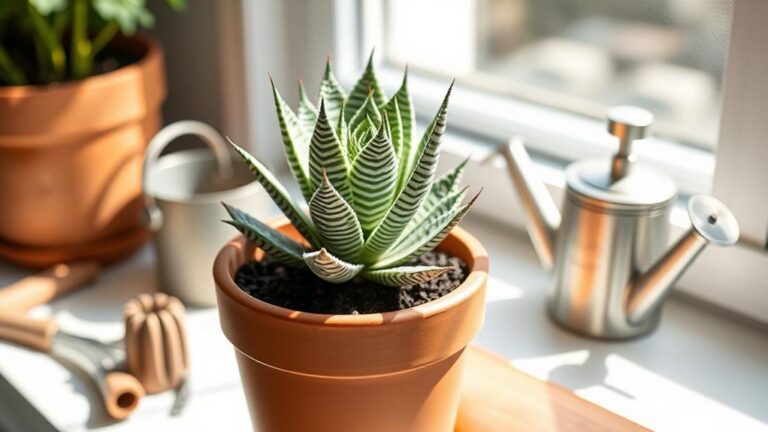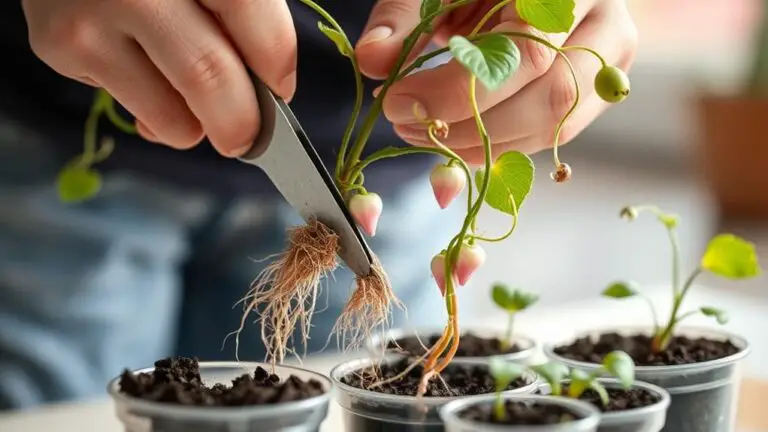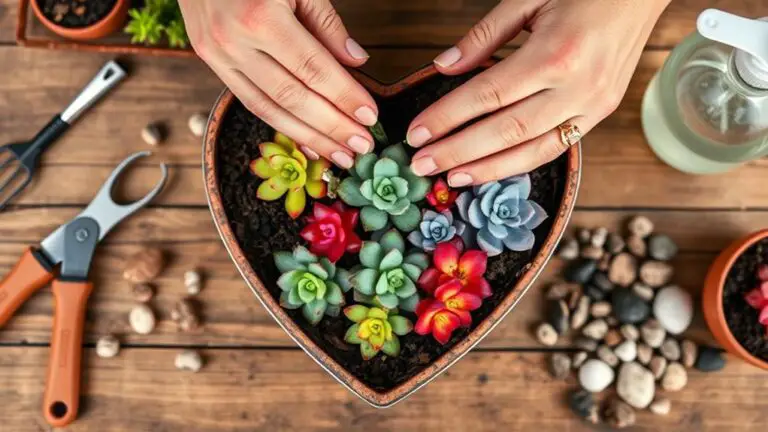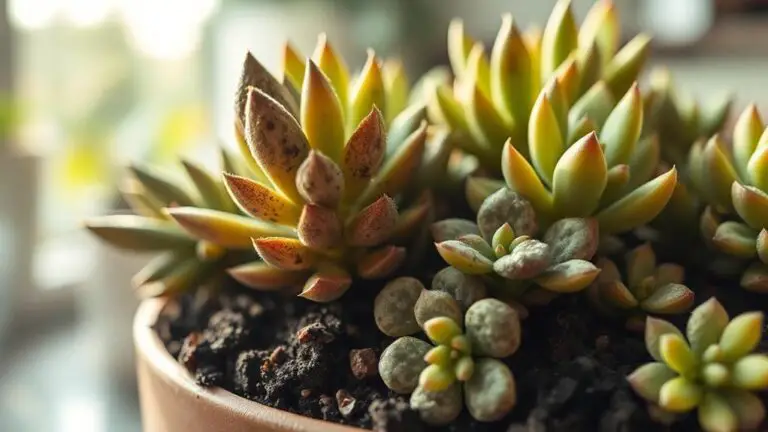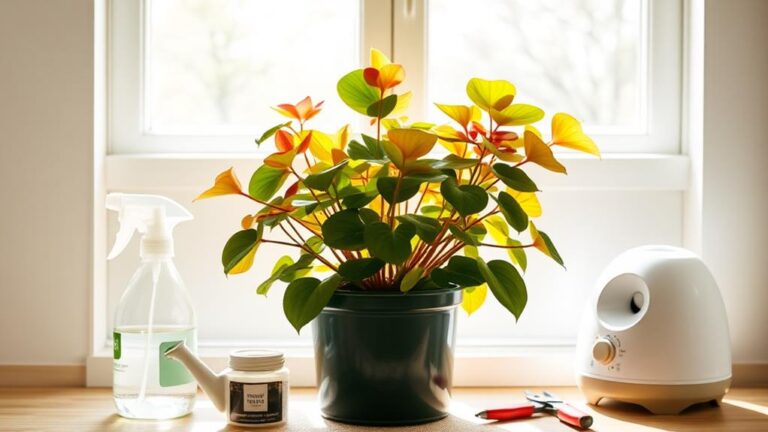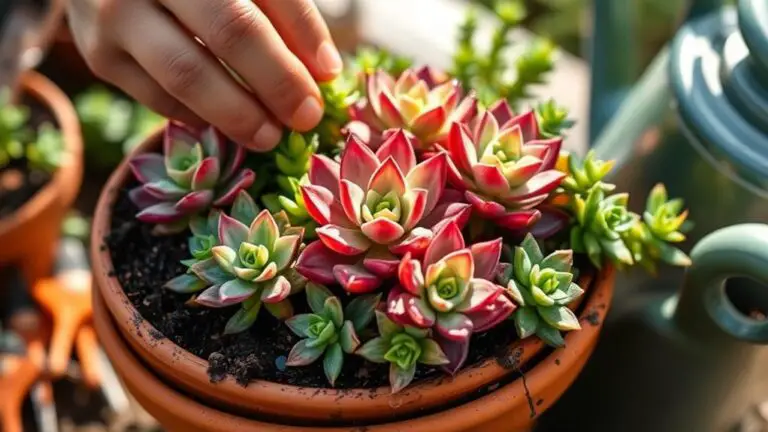Pachypodium Brevicaule Care Guide: Watering Sunlight and More
When caring for your Pachypodium Brevicaule, there are a few essential factors to keep in mind, starting with how you water and where you place it. You'll want to let the soil dry out completely between waterings, especially during its winter dormancy. Sunlight is equally important—position the plant near a southwest-facing window to guarantee it gets at least six hours of direct light daily. But that's not all; understanding soil drainage and maintaining the right temperature also play significant roles. Curious about how to keep this unique plant thriving year-round? Let's explore the specifics.
Watering Needs
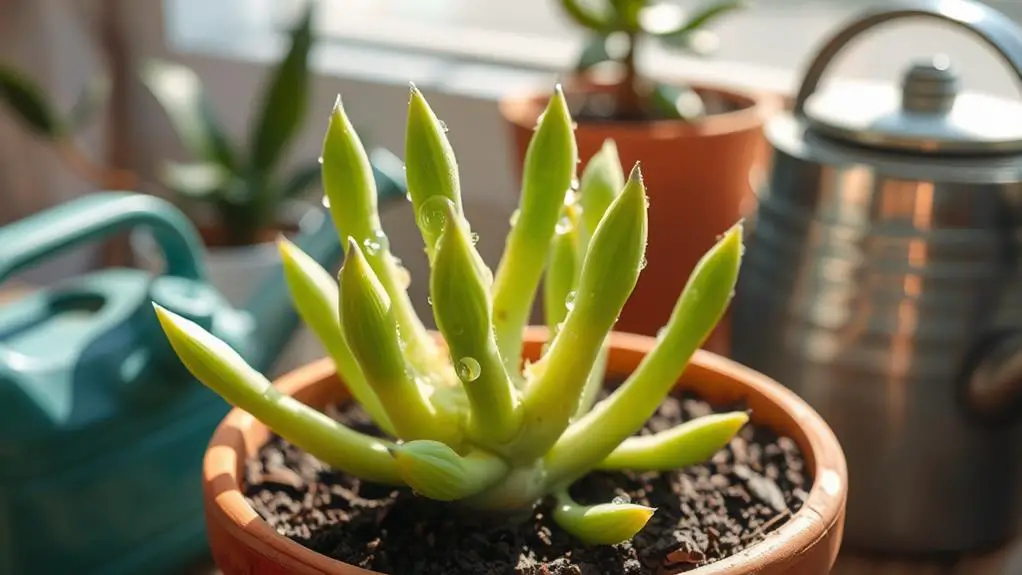
When it comes to watering Pachypodium brevicaule, it's important to let the soil dry out completely before giving it a thorough soak. This plant thrives when its watering needs are met with care.
Always use well-drained soil, like a cactus or succulent mix with 50-70% mineral grit, to avoid waterlogged roots. This helps the plant develop healthy roots and prevents root rot.
During the active growth period in spring and summer, consistent watering is vital. Allow the soil to dry out between waterings, then water thoroughly. You can check the soil by touching it; if it feels dry, it's time to water.
Too much water can harm your plant, causing yellowing leaves. If you notice this, reduce your watering frequency immediately.
In winter, Pachypodium brevicaule enters dormancy and loses its leaves. This is the time to almost stop watering completely, as the plant doesn't need much moisture.
Keeping the soil too wet during this period can be detrimental.
Sunlight Exposure
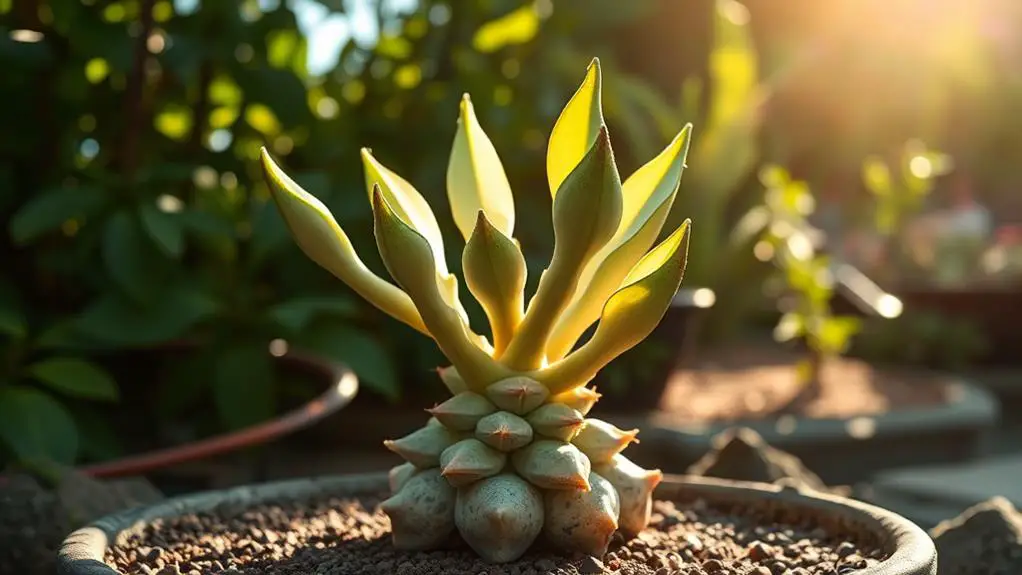
To keep your Pachypodium brevicaule healthy and thriving, make sure it gets plenty of bright light by placing it near a southwest-facing window indoors.
Without enough sunlight, you might see poor growth and yellowing leaves, which can ultimately harm or even kill your plant.
Aim for at least 6 hours of direct sunlight each day during the growing season to encourage those beautiful yellow blooms.
Optimal Sunlight Placement
Your Pachypodium brevicaule will thrive when it's placed in a spot where it can bask in bright, ample sunlight. For perfect conditions, find a location in your home that offers plenty of natural light. A southwest-facing window is ideal because it allows the plant to soak up direct sunlight for several hours each day. This exposure is vital for the plant's growth and overall health.
However, during periods of extreme heat, you'll want to shield your Pachypodium brevicaule from harsh sunlight to prevent leaf scorch. You can do this by using sheer curtains or moving the plant a few feet away from the window while still keeping it in a bright area. Balancing light exposure guarantees the plant gets what it needs without suffering damage.
Keep an eye on your plant's health regularly. If you notice yellowing leaves, it might be a sign that your Pachypodium brevicaule isn't getting enough light. Adjust its placement to make sure it's receiving the best exposure.
Effects of Insufficient Light
Without sufficient light, your Pachypodium brevicaule will struggle to maintain its vibrant health and robust growth. This plant thrives in bright light and full sun conditions, so insufficient light exposure can lead to poor growth and even decline.
If your plant is kept in a dark or shady location, you might notice yellowing leaves. This is a sign of stress and could also indicate potential overwatering.
A lack of adequate sunlight can prevent your Pachypodium brevicaule from blooming. Its vibrant yellow flowers, which typically appear in summer, need full sun to flourish. Without enough light, the plant may not bloom at all.
Additionally, if your Pachypodium brevicaule isn't placed near a southwest-facing window or a well-lit environment, it might become leggy or weak as it stretches toward any available light source.
Consistent sunlight exposure is essential for maintaining the overall health and vigor of your plant. It directly impacts its growth patterns and resilience.
Indoor Light Recommendations
Given the importance of adequate sunlight, let's focus on the best indoor light recommendations for your Pachypodium brevicaule. This succulent thrives in bright light, so placing it near a southwest-facing window is ideal. This spot provides the full sun exposure it needs to grow well and produce those beautiful yellow blooms in the summer.
Avoid placing your Pachypodium brevicaule in dark or shaded areas. Insufficient sunlight can cause poor health and a noticeable decline in growth. Watch for signs like yellowing leaves, which indicate that the plant needs more sunlight. If you notice these signs, try moving the plant to a brighter location.
While direct sunlight is vital, be mindful during extreme heat. Too much sun can lead to leaf burn, so you might need to provide some protection during the hottest parts of the day. This balance guarantees that the plant gets enough light without getting damaged.
Lastly, maintaining the minimum temperature is important for your Pachypodium brevicaule's health. Keep it in a warm environment to support its growth.
Soil Requirements
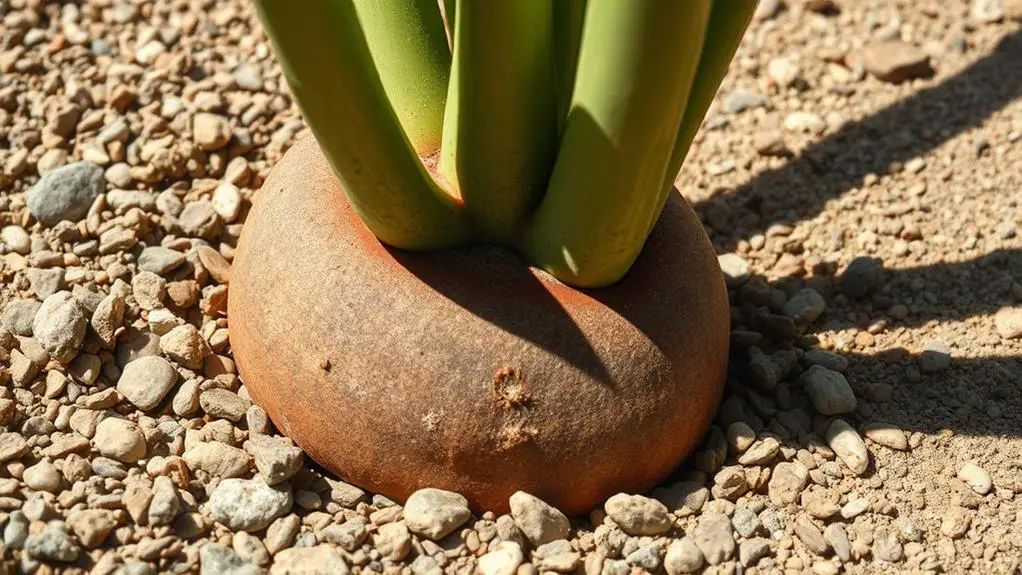
To keep your Pachypodium brevicaule healthy, you'll need a well-draining soil mix.
Aim for 50-70% mineral grit, like pumice or perlite, to prevent root rot.
Combining scoria, sand, and potting soil guarantees good drainage and aeration, letting your plant thrive.
Optimal Soil Composition
For Pachypodium brevicaule, the key to thriving lies in a well-draining soil mix that prevents root rot. You'll want to create a blend that includes 50-70% mineral grit. This helps guarantee good drainage and keeps the roots from sitting in water, which can be harmful.
To get started, use a mix of pumice, scoria, or perlite combined with sand and potting soil. These materials allow water to flow through easily and prevent the soil from becoming compacted. A pH level between 3.5 and 4.5 is ideal, so if you notice yellowing leaves, it might be time to check and adjust the pH.
Here's a helpful breakdown:
| Material | Purpose |
|---|---|
| Pumice | Enhances drainage, prevents compacting |
| Scoria | Adds aeration, supports root health |
| Perlite | Improves soil structure, keeps soil light |
| Sand | Increases drainage capabilities |
| Potting Soil | Provides organic matter, retains some moisture |
Regularly check the soil moisture and guarantee it drains well, especially during active growth periods. Using porous materials like pumice supports good drainage, so your Pachypodium brevicaule stays healthy and strong. With the right soil mix, you'll create the perfect environment for your plant to thrive.
Drainage and Aeration
Guaranteeing proper drainage and aeration is vital for the health of your Pachypodium brevicaule. This plant thrives in well-draining soil to prevent root rot and other issues. Aim for a soil mix that's 50-70% mineral grit like pumice, perlite, or scoria. These materials help the soil stay airy and prevent waterlogged conditions, which can be harmful.
To create the ideal soil, mix cactus or succulent potting soil with sand and additional drainage materials. This combination guarantees that water flows through easily and doesn't stagnate around the roots.
Regularly check the soil to affirm it drains well and isn't holding too much moisture. If the soil remains too wet, your Pachypodium brevicaule might show signs like yellowing leaves and general decline.
Maintaining a soil pH between 3.5 and 4.5 is also vital. You can adjust the pH using vinegar if needed.
Repotting your plant every 3-4 years with fresh soil will refresh its nutrients and maintain proper drainage. By following these guidelines, you'll provide a healthy environment for your Pachypodium brevicaule to thrive. Trust yourself and enjoy the process!
Temperature Tolerance
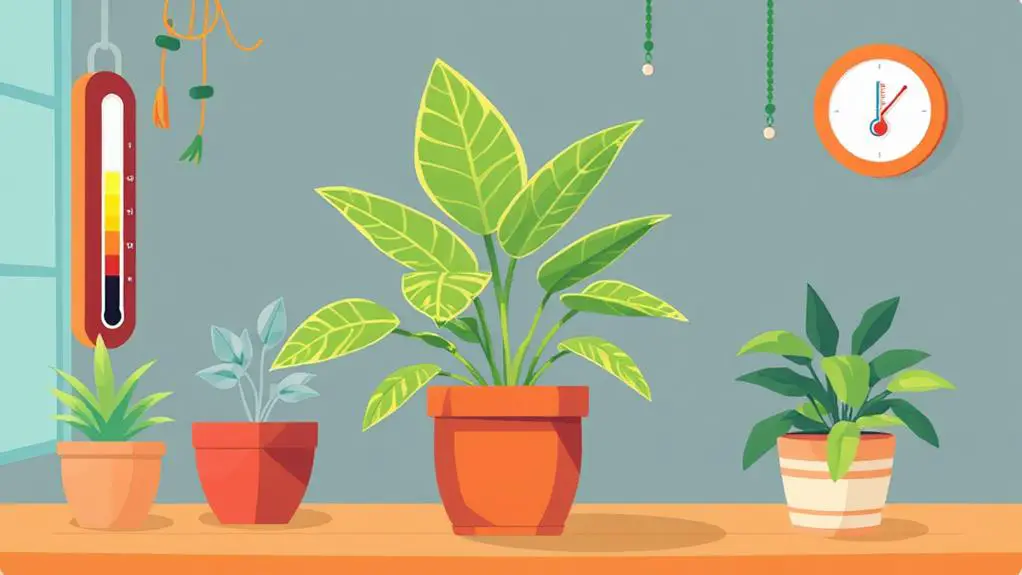
Pachypodium brevicaule is highly sensitive to cold, making temperature management vital for its health. It can't tolerate temperatures below 55°F, so you need to keep it warm to guarantee healthy growth.
During the winter, even though the plant may lose its leaves, protection from frost and cold temperatures is essential for its survival.
For peak growth, aim to keep the environment between 54-59°F (12-15°C). This range allows your Pachypodium brevicaule to thrive and prepare for the active growing season.
During winter months, maintaining a stable, warm environment prevents stress and helps the plant come back strong in the spring.
While some experienced gardeners have managed to keep their plants alive in freezing conditions with minimal watering, it's not recommended. The risk is too high, and the plant could suffer significant damage.
Instead, focus on providing a stable, warm setting.
Dormancy Care
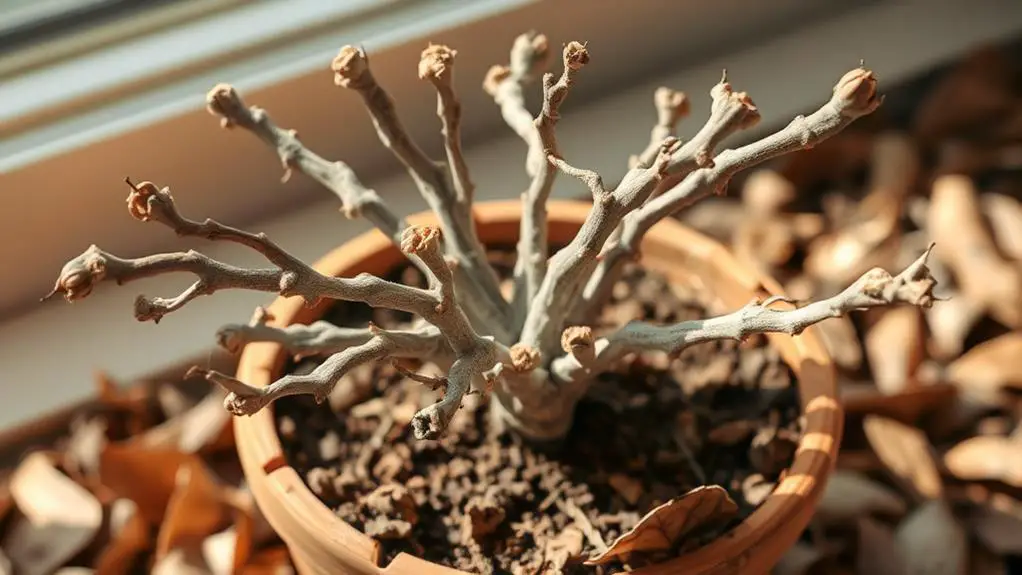
Although winter dormancy might seem challenging, it's a natural and essential part of the Pachypodium brevicaule's life cycle. During this period, your plant will drop its leaves and require no water until new growth appears in spring. This is vital for its health as it conserves energy and prepares for the growing season ahead.
Here are four key points to remember for effective dormancy care:
- Watering: Reduce the amount of water to zero. Overwatering can cause yellowing leaves and potential root rot. Wait until you see new growth in spring before resuming watering.
- Temperature: The plant can tolerate temperatures as low as 55°F, but freezing conditions can be harmful. Bring it indoors if temperatures drop below this threshold.
- Light: Place your Pachypodium brevicaule in a warm, bright location. This helps support healthy re-sprouting when dormancy ends.
- Monitoring: Keep an eye on the plant. Yellowing leaves during dormancy can indicate overwatering, so make immediate adjustments if you notice this.
Propagation Tips

Propagating Pachypodium brevicaule can be a rewarding experience for plant enthusiasts. These beautiful succulents can be propagated primarily from seeds or through grafting techniques. To start with seeds, sow them in sandy loam soil. Keep the temperature around 14°C and maintain high humidity for ideal germination.
Grafting is another effective method. You can use Pachypodium gaeyi or Pachypodium lamerei as rootstocks. When grafting, handle the plant's latex carefully to avoid damaging both the scion and the rootstock. Once grafted, place the young seedlings in a shady area for 7-10 days to help them acclimate.
Here's a quick reference table for your propagation journey:
| Method | Key Steps |
|---|---|
| Seed Sowing | Use sandy loam, 14°C, high humidity |
| Grafting | Use P. gaeyi/lamerei, handle latex carefully |
| Aftercare | Shade for 7-10 days, keep moist |
During the early growth stages, regular moisture is essential. However, avoid letting the plants dry out completely. This helps guarantee successful development. By following these propagation tips, you'll increase your chances of growing healthy Pachypodium brevicaule, turning your gardening efforts into a flourishing success!
Common Issues
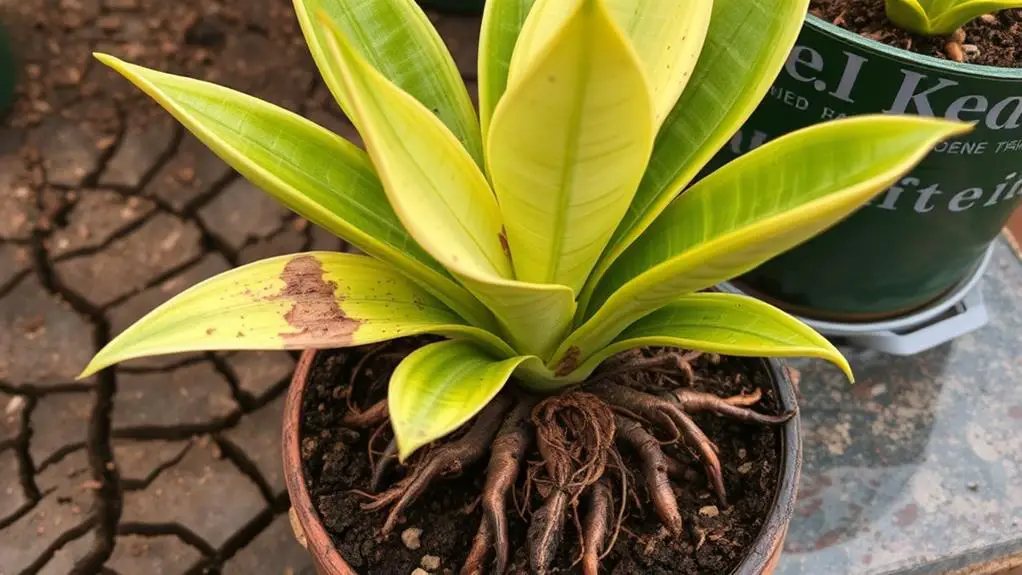
While mastering propagation techniques can set a strong foundation for your Pachypodium brevicaule, staying aware of potential common issues is equally important for maintaining plant health.
Let's explore some of the frequent challenges you might face:
- Yellowing Leaves: If you notice the leaves turning yellow, it's a sign of overwatering. Too much water can cause root rot, so you'll want to reduce watering immediately.
- Leaf Drop: It's normal for leaves to drop during winter dormancy. However, if this happens at other times, it could indicate stress from improper care.
- Poor Growth: Insufficient sunlight can lead to weak stems and poor growth. Make sure your plant gets bright light, ideally near a southwest-facing window.
- Soil Moisture: Keeping an eye on soil moisture is essential. If the soil stays wet too long, root problems can occur.
On the other hand, letting the plant dry out completely can hinder its growth.
Frequently Asked Questions
How Often Should I Water Pachypodium?
Water Pachypodium brevicaule thoroughly when the soil's dry to the touch. During winter dormancy, don't water it at all. In spring and summer, adjust watering based on conditions, ensuring soil dries out completely between waterings.
How to Take Care of Pachypodium Brevicaule?
Place your Pachypodium brevicaule in ample sunlight, preferably near a southwest-facing window. Water deeply, letting soil dry completely between watering. Use well-draining soil with mineral grit, maintain temperatures above 55°F, and fertilize during active growth.
What Temperature Does Pachypodium Brevicaule Like?
Pachypodium brevicaule prefers temperatures above 55°F. It thrives best between 54-59°F during its vegetative rest period. Make sure you protect it from frost and monitor for yellowing leaves, which indicate stress.
How Do You Care for a Pachypodium Plant?
You water it deeply when the soil's dry, avoid watering in winter dormancy, give it ample sunlight, use well-draining soil, protect it from frost, and monitor soil moisture to prevent overwatering.
Conclusion
Taking care of your Pachypodium Brevicaule might seem tricky, but you've got this! Remember to let the soil dry out before you water, especially in winter. Give your plant plenty of sunlight, ideally near a southwest-facing window. Guarantee good drainage and keep an eye on the temperature to keep your plant happy. Follow these simple tips, and you'll see your plant thrive. Keep growing and learning, and your green thumb will continue to flourish!


